#opb co.
Text
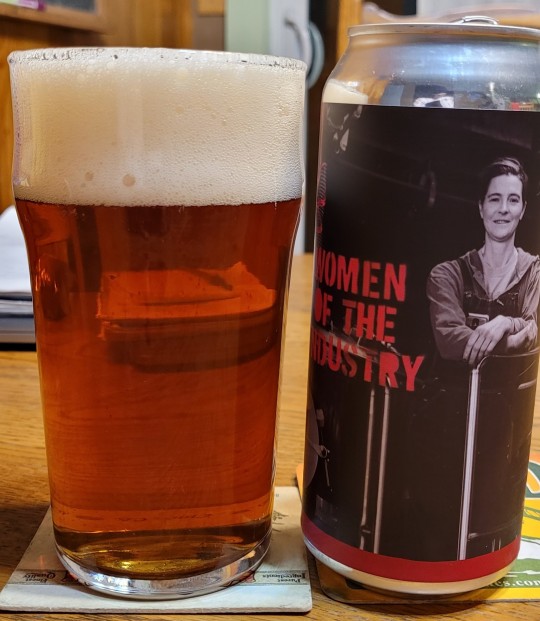

Chicks and beer . . .
#women of the industry#opb co.#extra special bitter#east kent golding#ellen shirrell#crooked lane brewing company#independent craft#oak park brewing co.#sacramento#california
5 notes
·
View notes
Text
Nike Co-founder Phil Knight gives $400M to benefit Black Portlanders

According to www.opb.org
" Phil Knight, the billionaire co-founder of Nike, is contributing $400 million to a new investment fund to support Black residents of Portland.
The gift from Knight and his wife Penny Knight to the 1803 Fund – an initiative revealed Monday – is meant to fund education services, art programs and other projects for Black Portlanders in the inner North and Northeast Portland neighborhoods once known as Albina.
Albina was the center of Black society and business in the early 1900s, but by the 1960s communities it had been decimated after city-backed urban renewal projects leveled homes and community hubs. These construction projects, which built spaces like the Memorial Coliseum, Legacy Emanuel Hospital, the Moda Center and a stretch of Interstate 5, cratered Albina’s Black population. The community, which is now represented by Eliot, Boise, Humboldt, Overlook and Piedmont neighborhoods, was further harmed by the decades of gentrification that followed these projects.
The 1803 Fund intends to repair some of this damage by investing in programs that support Black Portlanders. The fund was created by Rukaiyah Adams, the former investment chief of Meyer Memorial Trust and founding board member of the Albina Vision Trust, a nonprofit with a similar focus on economic investment in the historic Albina neighborhood. (Adams also chairs OPB’s board of directors). The Albina Vision Trust is perhaps best known for its work advocating for Black Portlanders via the massive project to expand Interstate 5 through the Rose Quarter."
Head over to www.opb.org for more
1 note
·
View note
Text
Hey, folks! Check out the wonderfully transcribed interview conducted by OPB’s Think Out Loud radio show. TOL interviewed our co-EICs, Bri Castagnozzi and Justine Norton-Kertson. Solarpunk media sits at the forefront of this conversation.
https://www.opb.org/article/2021/11/03/digital-magazine-solarpunk-hopeful-science-fiction/
Published Nov. 5, 2021.
Excerpt:
Miller: Brianna, what does solarpunk mean to you personally?
Castagnozzi: Personally, solarpunk is a means of an escape from a dystopian reality and also a sort of cultural blueprint for the future. Now I personally, as a Filipino American, I have seen just a skyrocketing in the past two years of hate crimes on Asian Americans. And I think to myself: I am tired of living in this dystopian present; let me work towards a future where marginalized people are safe from their environment and safe from bigotry.
#solarpunk magazine#solarpunk#Asian authors#Asian writers#filipino writers#interview#Oregon public broadcasting#think out loud
75 notes
·
View notes
Photo


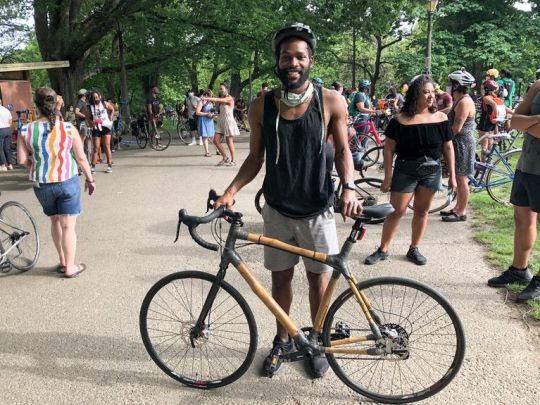
the portland black liberation ride, 19.06.2020.
“If you live day to day and never see people that look like you, it takes a toll. To have this moment, [to] see a flood of faces that reflect you makes a really big impact on your self-care and your healing.” —Jené Etheridge, ride co-organizer
read more: opb. 22.06.2020.
2 notes
·
View notes
Text
Amphibians vs. crustaceans at Mount Mazama: The expansion of non-native crayfish, introduced to the area in 1915 by Euro-American land managers, might soon lead to the extinction of the Mazama newt, a unique subspecies of the rough-skinned newt and an amphibian with a very small distribution range, living only in the waters of Crater Lake and small springs near its shoreline (in so-called “Oregon”). Though the rough-skinned newt is “the only terrestrial animal to contain tetrodotoxin (TTX), the same neurotoxin that is found in deadly saltwater puffer fish (Tetraodontidae) and blue-ringed octopus (Hapalochlaena spp.) [...] Mazama newts have extremely low toxicity levels compared with newt populations” throughout the rest of the Pacific Northwest, making the iconic Mazama newts of Crater Lake easier prey for the crayfish.



[Source: Mazama newt photo by National Park Service. Crater Lake photo by National Park Service. Crayfish photo by Washington Department of Fish and Wildlife, publicized by Ben Goldfarb for High Country News.]
The newt:
The rough-skinned newt (Taricha granulosa) is an ubiquitous and emblematic species of the coastal Pacific Northwest, ranging from northern California through British Columbia’s Raincoast. Some ecologists recognize there to be two subspecies of the newt: one which lives throughout the aforementioned range across the Pacific Northwest, and the other subspecies limited only to a single location at the lake in the caldera of the dormant volcano Mount Mazama. This proposed subspecies is Taricha granulosa mazamae, the “Mazama newt,” endemic only to Crater Lake, where it was the “top predator” before introduction of the crayfish. The other rough-skinned newts of the Pacific Northwest contain high levels of tetrodotoxin, but Mazama newts are relatively much less toxic; Mazama newts are also genetically and physically distinct.
(The caldera collapse that formed Crater Lake was instigated by Mount Mazama’s volcanic eruption about 7,700 years ago. Landscapes around the lake include forest typical of temperate rainforest, relatively drier montane conifer forests, and related Klamath Mountain and alpine Cascades regional ecology. Crater Lake is the deepest lake located entirely within US borders, at a maximum depth of near 1,950 feet or 595-ish meters.)

[Photo by Lee Katz, publicized by Ben Goldfarb for High Country News.]
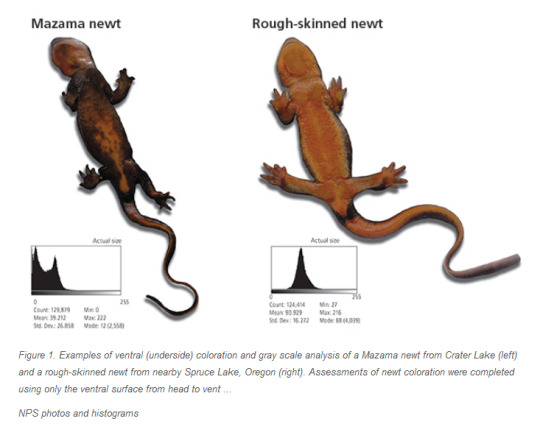
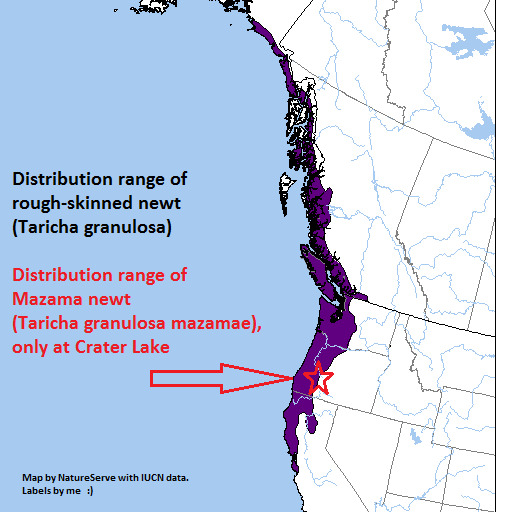
--
Here’s a look at the locations of remaining Mazama newt populations and non-native crayfish populations. From an important summary of the research on newts and crayfish: “The impact of introduced crayfish on a unique population of salamander in Crater Lake, Oregon.” M. W. Buktenica, S. F. Girdner, A. M. Ray, D. K. Hering, and J. Umek. Park Science Vol. 32 (2015).

How the crayfish arrived:
Pacifastacus leniusculus is a crayfish that lives widely across the Pacific Northwest, but it did not live in Crater Lake until its introduction
An excerpt from a nice and accessible article on the subject:
Scientists at the park are finding that crayfish and Mazama newts don’t really get along. “Where crayfish occur, we don’t find newts. And we only find newts where there are no crayfish,” Buktenica says. Not only do they compete for the same food, but studies at the park show crayfish chase and harass the newts, causing them to flee. And in some cases, the crayfish prey upon the newts.
“They’re virtually the perfect invader,” Buktenica says. “They eat algae. They eat plants. They eat aquatic insects and worms and snails. They’ll eat amphibians. They’ll eat small fish, they’ll cannibalize their own. And they’ll eat dead and decaying fish as well.”
Conversely, the Mazama newt is the ideal prey. After thousands of years evolving without predators, the newt lost its best weapon: a potent neurotoxin that can kill. [...]
The story of the crayfish in Crater Lake begins more than 100 years ago - back when getting to the future national park from Medford took five days by horse and wagon. To attract visitors, early conservationists began stocking the lake with game fish like trout and salmon. [...] In 1915, park managers introduced the signal crayfish from surrounding Northwest lakes to feed those fish.
[Source: Jes Burns. “Perfect Invaders: How Crayfish Are Threatening Crater Lake's Smallest Creatures.” OPB. December 2015.]


[Source: National Park Service.]
The scale of the danger posed by the crayfish:
The abstract from the 2015 Park Science article [Buktenica, et al, 2015]:
The signal crayfish (Pacifastacus leniusculus) was introduced to Crater Lake in 1915 and is now displacing a native salamander. Before the introduction of this crayfish species, no crayfish existed in the lake. A proposed subspecies of the rough-skinned newt (Taricha granulosa), the Mazama newt (T. granulosa mazamae) is reportedly endemic to Crater Lake, Oregon. The Mazama newt is morphologically, genetically, and physiologically distinct from populations of newts outside of the lake. Observations by park biologists through the 1900s suggested a decline in Mazama newt distribution and an increase in signal crayfish abundance, which led us to investigate current distribution, relative abundance, and interactions between crayfish and newts. Results indicate that crayfish have expanded in distribution to occupy nearly 80% of the lakeshore. Newts remain in areas that crayfish have yet to invade but are almost entirely absent in areas occupied by crayfish. Isotopic signatures of carbon and nitrogen in newt and crayfish tissue indicate that the two species eat similar food items and occupy a similar position (primarily predacious) in the food web. Abundance of other aquatic invertebrates was dramatically reduced in locations with crayfish compared with areas of the lake without crayfish. Mesocosm experiments conducted with newts and crayfish revealed that crayfish prey on newts, displace newts from cover, and generally alter newt behavior when the two species co-occur. This evidence, taken together, suggests that further crayfish expansion likely will cause additional declines in newt abundance and distribution, and could lead to extinction of the unique Mazama newt. [End of excerpt.]
Here’s a look at the rapid spread of the non-native crayfish, between 2008 and 2013. [Source: Buktenica, et al, 2015.]

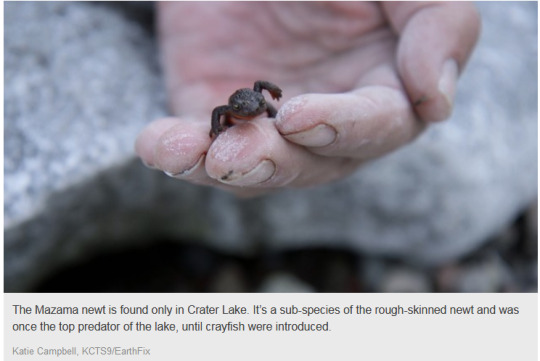
‘“With the loss of its toxicity, [the newt is] left virtually defenseless,” Buktenica says. And that’s not all, says John Umek, a PhD candidate at the University of Nevada Reno. He’s been studying the effects crayfish have on other animals in the lake. “At these areas where we don’t have crayfish, we have a ton of different species of organisms,” Umek says. “We have lots of snails, lots of caddises, mayflies. And when crayfish come in, a lot of those just disappear.” [...] The sobering reality is crayfish will likely never be eliminated from Crater Lake.’ [Source: OPB. Photo, below, of a Mazama newt near the shore of Crater Lake, via National Park Service.]

20 notes
·
View notes
Text
The Victorian Internet and Today
As time evolves, so does technology. Throughout the book The Victorian Internet, written by Tom Standage, readers are able to see how our communication came to be what it is today because of the scientists who were so proactive in creating something long lasting and great. Since April of 1746, scientists have strived to prove that interactions between individuals could take place over great distances. During this time, this was first proven with a mile-long chain of monks who felt an electric shock from the wire they each held. In this moment, finding that electricity could be sent over wire successfully sparked the intrigue and drive for scientists to create something more, like the telegraph.
To begin, Claude Chappe was a scientist who most successfully performed the earliest version of the telegraph. With the help of his brother, he used his specialized “signaling system”. This system worked by clanging a casserole dish that corresponded to numbers on two clocks that only had the second hands. They were able to synchronize times that they then translated into letters, words, and phrases. Because this was auditory, they were limited by distance. However, knowing this, he was inspired to create a visual design. This was a five-foot tall, pivoting wood panel that was painted black on one side and white on the other. It worked by flipping the panel to correlate the correct numbers of their prior method. To extend distance more, they used telescopes at their various sites. On March 2nd, 1791, the brothers were able to successfully send messages from Brulon, France to Parce, France, approximately ten miles away. The entire experiment took about four minutes to transmit. A friend of Chappe’s, Melito, suggested name “telegraph” for the technology. Thus, the telegraph was born.
Wanting to push the limits of his technology further, Chappe designed a new model of the visual telegraph that consisted of two rotating arms on the ends of a longer rotating bar. These rotating bars created various angles that allowed for 92 different combinations for letters, numbers and syllables. A codebook with 92 pages was created and allowed for total of 8,464 total combinations by transmitting two separate codes. A pulley system was later integrated to make the telegraph bars easier to control. After seeing how successful the work was, the idea was brought to National Convention of France to test how far messages could be sent. The test took eleven minutes for the three towers to send a message, but was successful. Pleased by their work, France constructed the Paris-Lille Telegraph line, which consisted of fifteen telegraphs in a row between the two cities to translate messages for the French Republic. It was later extended to Dunkirk, and another telegraph line in eastern France was built a few years later. By the mid-1830s there were approximately 1,000 telegraphs in Europe.
On another side of the globe, Samuel Morse in America was also working on the electric telegraph. He created a method of communication by using short and long bursts of current, that would later develop into dots and dashes, that correlated to various numbers and letters in a codebook. After finding this successful, he then created a way for the dots and dashes to be recorded on paper and then translated by their receiver. The major problem he faced was that only short distances worked, so he reached out to a friend, William Fothergill Cooke, who knew Michael Faraday, for help. Faraday was well known and respected for his knowledge in electricity and electromagnetism. After getting his information and after many tests, Morse teamed up with Leonard Gale and they were able to successfully make Morse Code messages send through ten miles of wire, inspiring Morse to push the technology further. It also took away the use of a codebook as well. Cooke had gone on to partner with Charles Wheatstone and they successfully a created quick, five-pin needle telegraph of their own, but it only could perform 20 letters and had no codebook. As most modern historians report, Morse Code was on its way to becoming one of the most important technologies in history.
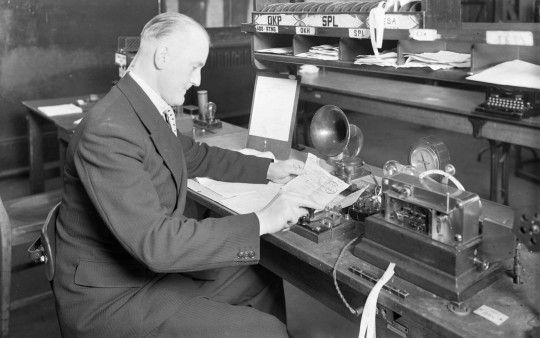
This week in tech. (2017, May 04). Retrieved from https://www.telegraph.co.uk/technology/connecting-britain/significant-demonstration-morse-code/
Looking further, in 1837 Cooke and Wheatstone identified a niche market for their product; the London Birmingham Railway, the Great Western Railway, and the Blackwall Railway. Through the years 1838 to 1868, the telegraph would be monopolized by Western Union in the U.S. Per Du Boff, author of Business Demand and the Development of the Telegraph in the United States, “The industry began with a single monopoly patent, grew through a wild, disorganized adolescence, and matured into a national monopoly, Western Union” (Du Boff 448). This monopolization starts from Ezra Cornell who’s purchasing on patent rights for many Midwestern lines as Western Union comes into play (Du Boff 489). Which Western Union makes an agreement with Cornell in order to control these lines. In order to expand the networking of telegraph services. After patents were bought, Western Union goes through State regulations in order to build State-to-State lines.
With the patents bought out between companies, it was hard for competition to rise. Without competition, poor management was maintained throughout the lines. “Firms that provided low quality would lose their customers” (Du Boff 490). “However, without competition, no punishment was possible, and firms underprovided quality” (Du Boff 490). So, for the telegraph strive, competition is required for the device to grow. With competition, between other firms, higher quality telegraph could’ve been built in response.
In 1842, Morse went to Congress to get funding, and he received $30,000 towards building an experimental line between Baltimore & Ohio Railway Co. A couple years later in 1844, the Whig National Convention took place and Morse successfully was able to transmit the names of the nominees before they arrived. The line was between Washington and Baltimore, and although he was successful, the telegraph at this point was still viewed as a novelty, not as a way to communicate.
Finally, in 1852 there was a rapid growth seen in the usage of the telegraph. In 1861, the Transcontinental telegraph line was complete. With the increased use of the telegraph, communication between states in the United States became a regular occurrence. According to Tomas Nonnenmacher (1997) “the telegraph … operated between states, making it an important test case for state regulation of interstate commerce” (p. 489) Particularly, Nonnenmacher compares the way in which interstate telegraphy regulations were similar to the regulations put into place for canals and railroads across state lines. This led to the development of telecommunication, although it was of poor quality at the time. Unfortunately, it also made previous communication methods obsolete, such as the Pony Express.
Telegraphs soon became part of everyday life. But it was expensive, so one had to be richer than not to afford this method of communication. In January of 1854 Cyrus W. Field, a self-made wealthy businessman of the paper trade, met with Frederic N. Gisborne. Gisborne was an English engineer focused on extending a telegraphy network to Newfoundland. Gisborne, at this meeting, convinced the scientifically ignorant Cyrus Field to inquire further and participate as the business-manager and backing agent for the project. Field wrote to Morse and to Matthew Fontaine Maury regarding the feasibility of the project and the best route for the wiring.
Two years later the New York - St. John’s line was completed. Field had, at this point, also established the New York, Newfoundland and London Telegraph Company. During a business venture in London, Field met John Brett who became involved with building a transatlantic telegraph. Morse was also in London at the time, and successfully demonstrated the ability to send long-distance signals across a circuit. This finding spurred Field and Brett to establish the Atlantic Telegraph Company. They persuaded the British and American governments to provide funding for a transatlantic telegraph given the government being later allowed free message carrying. Dr. Edward Orange Wildman Whitehouse was appointed the official electrician, although his knowledge of telegraphy was self-taught and he lacked experience and training. He was appointed by Field, however, for his trust in experimental results over theory. Ultimately, Whitehouse’s incompetence led to the first three attempts at laying the telegraph cables to failure in 1857. On the fourth attempt, the cable was successfully laid across the Atlantic ocean, however within one month the telegraph system ceased to function. The public outcry and William Thomson’s demonstration against Whitehouse’s system lead to Whitehouse being fired.
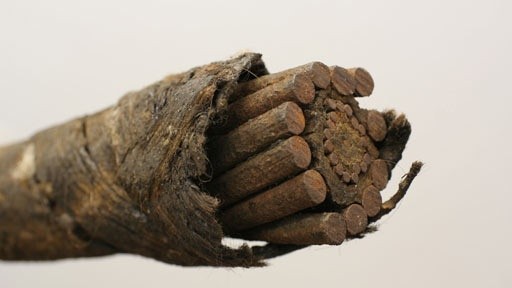
Investigations Transatlantic Cable. (n.d.). Retrieved from http://www.pbs.org/opb/historydetectives/investigation/transatlantic-cable/
William Thomson later became the leading figure for submarine telegraphy. In 1864, six years after Whitehouse was fired, Thomson completed a working telegraph across the Persian Gulf. The Atlantic Telegraph company utilized Thomson’s advances in telegraphy to petition and again work toward creating a transatlantic telegraph network. In 1865 the world’s largest ship at the time, the Great Eastern, set sail laying cable for the Atlantic Telegraph Company’s second attempt at a transatlantic telegraph. The cable itself utilized William Thomson’s advice and findings from his success on the Persian Gulf. Unfortunately, after about ⅔ of the cable was laid it broke and there were no successful efforts to retrieve it from the ocean’s depths. Later that year the Great Easternset out on the second attempt to lay cable, which turned out to be successful. Hence, the first transatlantic telegraph system was established.

Investigations Transatlantic Cable. (n.d.). Retrieved from http://www.pbs.org/opb/historydetectives/investigation/transatlantic-cable/ e
The transatlantic telegraph system created a couple problems. Particularly, due to increased demands of telegraphs, there became consistent back-ups. Eventually it came to the point that message-runners would travel the couple hundred feet between telegraph centers to distribute messages for re-transcription. This, however, instilled the idea that telegraphy was just an expensive postal service. To solve this problem, in 1853, Josiah Latimer Clark, an engineer of the Electric Telegraph Company, proposed a “steam-powered pneumatic tube system to carry telegraph forms the short distance from the Stock Exchange to the main telegraph office.” He tested this idea. This idea was implemented underground between two telegraph stations, and was capable of carrying up to five messages simultaneously. It became clear, however, that only five messages at a time could still not keep up with the demand. Hence, in 1858, a second set of pneumatic tubes was introduced and a partial vacuum tube was tested, although led to an explosion and rejection of this item for carrying messages. In 1870, however, a breakthrough was made. The tube diameter was increased, allowing the ability to carry up to sixty messages simultaneously. The tube diameter increased to be able to carry up to sixty messages simultaneously, significantly impacting the public perception back toward the use of the telegraph.
Additionally,people were finding opportunities for fraud, theft, and deception in regards to the telegraph. It all started in the 1830’s when the Blanc brothers tried to bribe a telegraph worker into putting mistakes on messages so they could figure out if the stock market went up or down that day. After that incident, in the 1840’s, people continued to take advantage of the telegraph by placing bets on horse races when, they already knew the results. Many similar incidents happened because, people were able to break codes from the telegraph. This was illegal and, only governments and officials of the telegraph companies had access. There was a need for codes because, many people did not trust the telegraph. They never knew who would end up seeing their messages when they were being transmitted.
In 1864 the French government decided that they needed to do something about the codes. The major countries of Europe were invited to a conference in Paris to agree on a set of rules for international telegraphy. By 1865, The International Telegraph Union (ITU) was born. They decided that anyone could have access to the codes. In 1845 the U.S. had already adopted this concept. Francis O.J. Smith and Henry J. Rogers published a book and dictionary dedicated to the telegraph and codes. Codes were also much cheaper to send for people because, several words could be replaced.
In 1870 the demand for codes grew because of the submarine telegraphy. This allowed messages to be sent by distant lands. Companies also began to develop codes that were specific to them. In 1875, The International Telegraph Union tried to stop companies from bending the rules. They imposed a fifteen letter limit. This resulted in people following the rules but, coming up with obnoxious codes. In 1885, they tried to tighten the rules even more by imposing a ten letter limit. They also decided that, words had to be genuine.
In 1887, Franklin T. Primrose sued the ITU because, there was an error with him misplacing a latter which, changed the meaning of his whole message. He had an option of the message being verified and chose not to so, he lost. Because of this, in 1890, there were look up books provided to help with error correction. There was also a official vocabulary of all permitted words. If anyone used a permitted word, they would be charged. In 1894 the ITU came up with a 1st edition of a vocabulary book but, it got scrapped because common words were omitted. They began starting a new one but, in the end, it was too much work. People ended up getting what they wanted, which was to send coded messages.
In 1872 The Western Union Telegraph Company in the U.S. implemented a way to transfer money using the telegraph. They started with $100 and by 1877, they were transferring $2.5 million dollars annually in over 38,000 transactions.
Before the invention of the telegraph news could only travel as fast as people could. Newspapers would compete with one another to see who could get the news first. Once the telegraph became more widespread newspapers used it to get information from all around the world faster than they ever have before. The Times had the market on newspapers up until the 1820’s when the Journal of Commerce and Courier and Enquirer became popular as well. In the 1830’s newspapers became a staple form of media for the public to read due to the cheap, mass produced publications.
Because of the new access the Times was able to publish reports from Cape Town and Rio in their January 9th, 1848 edition. It was not long after the newspapers started using the telegraph that the government used it as well. They used it to communicate with their troops overseas as well as to bring news from the front lines back to the people. In 1859 Reuter, a prominent man in the newspaper industry of the time, obtained a copy of a crucial speech from the French government concerning their relations with Austria and gave it to the Times within two hours. He also used the telegraph to report from all three camps of the French and Sardinian war.
The government grew weary of the reach that telegraphs have during times of war. With the transmissions being able to be sent almost anywhere it was easier for enemies to get ahold of critical information from the opposing army. Not only is that a possible complication caused by the telegraph; but access to one can give an army an advantage. That was proven during the Fashoda incident when British and French armies found themselves in a standoff in Sudan. Due to their access to a telegraph the British army was able to get correspondence back to Britain relaying untrue information about the state of the French troops which, once relayed to the French government, caused the French to be ordered to retreat. Despite all of the negative effects of the telegraph people still had the hope that the telegraph would bring the world together in peace.
After 1850, the telegraph caused a wave of accelerated information. Through the communication of telegraph people were able to communicate with each other in a matter of seconds. With that said, this also changed how business could operate. In the United States the telegraph was used mostly for businesses to communicate prices of products such as; cotton, metal, or other goods. A businessman, stationed in New York, could send a telegram asking for inventory in Chicago, and have their answer in minutes. Telegrams were sent and received between businesses, which created the network for businesses to prosper. Which also caused major telegraph companies to profit and expand. It was said that by the 1880s, Western Union and monopolized the telegraph business, controlling almost 80 percent of telegram traffic.
In some other countries, like Europe, the telegraph was used by the public. Europe had given control of the telegraph to the Post Office in 1869. Where the Post Office devised telegram addresses in order to direct messages. The Post Offices offered different services or rates to businesses in order to increase telegram usage. Which worked effectively well, as some businesses had direct lines installed within their organizations. In order to cut time of going to the Post Office to deliver messages.
The demand for telegraphs were endless. Businesses needed updates on information 24/7. In the world of stocks, the demand for price fluctuation was crucial. In the U.S. stock for gold was a hot item for brokers to know. The telegram could relay the prices, but the price for sending each message could potentially cause profit loss. So, the creation of “Gold Indicators” were created in order to inform brokers of gold stocks.
Dr. S. S. Law created the gold indicator, inspired from the telegraph, to create a more formal communication method within the Gold room. Law’s device consisted of two drums marked with figures. Connected through an electrical wire it could give a live feed of what gold prices were at any moment’s notice. These devices could be installed in offices for other brokers to have a direct feed. The device was later improved by E. A. Callahan in 1867, which was an immediate success as well. Callahan’s device made a ticking noise, which printed the prices on a piece of paper. This was quite a device to have for merchants and businessmen to have at their disposal. With the invention of new devices, the telegraph could soon have other competition to compete with. After the 1870s, the community that the telegraph had created would see a change in interaction.
Overall, the telegraph changed dramatically throughout the years. What was once seen as something unimportant and meaningless, suddenly became a necessity people could not live without. There have been advantages in communicating with loved ones and businesses, but also disadvantages having to deal with corruption and theft from people taking advantage of this new innovation. However, despite all of this, the telegraph became part of our society and led towards the ease and efficiency we are able to have today in communicating worldwide with one another.
References:
Du Boff, R. B. (1980). Business demand and the development of the telegraph in the United States, 1844 - 1860. The Business History Review, 54(4), 459-479. doi:10.2307/3114215
Jepsen, T. (2018). “A new business in the world”: The telegraph, privacy, and the U.S. Constitution in the nineteenth century. Technology and Culture, 59(1), 95-125. Doi: 10.1353/tech.2018.0007
Nonnenmacher, T. (1997). Law, emerging technology, and market structure: The development of the telegraph industry, 1838-1868. The Journal of Economic History, 57(2), 488-490. Retrieved from https://www.jstor.org/stable/2951052
Standage, T. (2007). The Victorian Internet. New York: Walker Publishing Company.
1 note
·
View note
Text
Week 3: The Start!
81 percent of women have experienced sexual harassment (NPR, 2018). Stopping sexual harassment in the workplace is important because people shouldn't feel unsafe in the place where they work. People spend an average amount of 38 hours of their week at their jobs. They should feel safe at their place of work rather than living in fear of what an unwanted co-worker would do to them. Oregon State's definition of sexual harassment in the workplace “is defined as unwelcome sexual advances, requests for sexual favors, or conduct of a sexual nature (verbal, physical, or visual), that is directed toward an individual because of gender. It can also include conduct that is not sexual in nature but is gender-related. Sexual harassment includes the harassment of the same or of the opposite sex” (Technical Assistance for Employees). The definition on its own is clear and does cover many different areas all at the same time, so nothing should be changed to the official definition. To improve the definition, giving specific examples to show what is and is not acceptable, there are some markers off sexual harassment such as, “Touching or grabbing of a sexual nature… Repeatedly standing too close to or brushing up against a person… Repeatedly asking a person to socialize during off-duty hours when the person has said no or has indicated he or she is not interested… Repeatedly making sexually suggestive gestures” (Sexual Harassment Policy).
Co-workers or superiors shouldn't be sexually harassing each other in and out of their workplace. Companies need to take stronger action in punishing the harassers instead of just switching schedules, but taking major action that shows the harasser that it is a serious issue by showing the harasser that there is major consequence to their actions, such as leave without pay, pay cut, or in extreme cases, being fired. Mentally, sexual harassment victims have to relive their incidents every time they go into work, causing much stress they feel the need to leave their current place of work in order to get away from their harasser. People in higher up positions should not be pressuring employees that have been sexually harassed to not speak up of what happened in and out of the workplace. For instance, Harvey Weinstein pressured people that he sexually harassed to keep quiet. If the people did speak they would get sued for defamation of character. Companies and places of work should not allow employees who have sexually harassed other employees. Places of work should not invalidate other peoples experiences of sexual harassment. Places of work should not promote a polarizing environment where employees cannot feel the need to speak up and share their experience or issue. We care about the issue because nothing is being done to prevent or stop sexual harassment.
75 percent of workplace harassment victims experienced retaliation when they spoke up. All companies have policies to keep other employees quiet and do not resolve the issue within the workplace besides having a meeting discussing why you should not touch your co-workers. At Salem Health Hospital and Clinics five women came up to speak up about sexual harassment in the workplace but nothing was done about it, (Karol, 2018). One woman went up to her supervisor and told about a man in the workplace that would be consistently be sexually harassing her. Her supervisor did nothing about it. Then after a few months, she found other females at the hospital that have experienced the same thing, so they went and told their stories together hoping that would make an impact but it did nothing except make a schedule change. Sara Gelser is an Oregon State Senator, who come out in November 2017 with allegations of being sexually harassed by Senator Jeff Kruse. When Gelser came out about her story, “one Republican lawmaker told Gelser a legislative committee was prepared to “rip her to shreds,” and Senate Minority Leader Jackie Winters, R-Salem, allegedly told Gelser she needed to “learn how to deal” with working with Kruse” (VanderHart, 2019). House Speaker Tina Kotek showed her support for Gleser saying, “she has always been personally supportive of Gelser, who she said showed “tremendous courage” in coming forward to report Kruse’s behavior”(VanderHart, 2019). Overall, Gelser was met with little that rectified the situation and was largely met with scrutiny from her colleagues as well as the public.
This issue only took a couple of people to make waves with their voice, bringing attention to big industries that have sexually harassing employees for years. It is ridiculous that nothing or no one has made strides in the issue until the #TIMESUP movement that has been happening for over a year now.
People are more aware of their surrounding and are more aware of what is happening around them. The more attention brought to the problem, the more the issue can be resolved. Hashtags have been created, bringing attention to the issue. It has brought people to recognize actions from the past into the present. This causes people to be more aware of their surroundings, recognizing what is and is not appropriate or acceptable. Companies need to take stronger action in punishing the harassers instead of just switching schedules, but taking major action that shows the harasser that it is a serious issue by showing the harasser that there is major consequence to their actions, such as leave without pay, pay cut, or in extreme cases, being fired. This problem still remains unsolved, and there are not many things being done to solve it. More people are becoming more comfortable coming out and speaking up, but there are still many who are uncomfortable and keep the issues to themselves. The more people who speak out and bring attention to the problem, the more the issues comes to being resolved.
Resources:
Chatterjee, R.(2018, February 21).A New Survey Finds 81 Percent Of Women Have Experienced SexualHarassment. NPR. Retrieved from http://www.npr.org/sections/thetwo-way/2018/02/21/587671849/a-new-survey-finds-eighty-percent-of-women-have-experienced-sexual-harassment
Karol, Gabrielle. (2018, November 29). 5 Women Say Salem Health Mishandled Sexual Harassment Complaints. The KOIN6. Retrieved from https://www.koin.com/news/special-reports/5-women-say-salem-health-mishandled-sexual-harassment-complaints/1622768681
Sexual Harassment Policy. Retrieved from https://www.state.gov/s/ocr/c14800.htm
Technical Assistance For Employees. Retrieved from https://www.oregon.gov/boli/ta/pages/t_faq_tasexhar.aspx
VanderHart, D, Dake, L. (2019, January 3). Investigation: Harassment Made Oregon's Capitol A Hostile Workplace. The OPB. Retrieved from https://www.opb.org/news/article/oregon-capitol-sexual-harassment-hostile-workplace/
Wagner, Jayce. (2018, August 31).Two Lawsuits Allege Campaigns of Groping and Harassment in Portland Businesses. Willamette Week. Retrieved from https://www.wweek.com/news/courts/2018/08/31/two-lawsuit-allege-campaigns-of-groping-and-harassment-in-portland-businesses/
1 note
·
View note
Text
2018 Holiday Special Programming

Candles Burning Brightly 5 PM – 6 PM
A one-hour celebration of Chanukah, the Jewish Festival of Lights with an exploration of Chanukah foods and traditional activities ... and plenty of music.
Friday, December 21st
WVTF Music
RSO Holiday Pops 2 PM – 4 PM
It's Southwest Virginia's largest holiday concert celebration and an unbeatable experience! This year, David Stewart Wiley conducts Holiday Pops with all the magical elements you have come to expect - high energy, familiar carols, lots of holiday warmth and a surprise or two! Featuring Roanoke Symphony Orchestra, Roanoke Symphony Chorus, Blacksburg Master Chorale and the Roanoke Valley Children's Choir.
Roots Down Holiday Special 10 PM- 12 AM
Luke Church features all holiday music. New and classic songs from John Prince, Emmylou Harris, Bruce Cockburn, Bonnie Raitt, J.D. McPherson, Tracy Chapman, plus some surprises along the way.
Saturday, December 22nd
Roots Down Holiday Special 10 PM- 12 AM (repeat)
Luke Church features all holiday music. New and classic songs from John Prince, Emmylou Harris, Bruce Cockburn, Bonnie Raitt, J.D. McPherson, Tracy Chapman, plus some surprises along the way.
Sunday, December 23rd
Studio B Holiday Music 2 PM – 4 PM
A celebration of the season on Studio B Sunday December 23 with holiday music from Balsam Range, Doyle Lawson and Quicksilver, Darin and Brooke Aldridge, Becky Buller, Rhonda Vincent, Ralph Stanley, Seldom Scene, and plenty of good bluegrass cheer.
Last Quarter Holiday Special 8 PM – 12AM
Four hours of jazz Christmas and holiday music yule never forget. Josh Jackson hosts the merriment with accompaniment from the greatest jazz musicians of yesterday and today.
Monday, December 24th
WVTF Music
Carols and Cheer 9 AM – 10 AM
Classical24 host Scott Blankenship reviews his favorite carols this holiday season. Audiences will love singing along as the two share their top picks for the Christmas season, performed by today's leading artists and ensembles.
A Festival of Nine Lessons and Carols 10 AM – 12 PM
Hosted by Michael Barone, this is a live service of spoken-word and music (choral and organ) broadcast from the chapel of King's College in Cambridge, England. The 30-voice King's College Choir performs the legendary Festival of Nine Lessons and Carols service of Biblical readings and music.
A Jazz Piano Christmas 8 PM – 9 PM
Join the Kennedy Center and NPR Music for this annual holiday tradition highlighting jazz pianists and their favorite seasonal music. This year, Jason Moran will be joined by artists including Grammy® Lifetime Achievement Award recipient Booker T. Jones and James Francies, Felix Contreras hosts.
An Afro Blue Christmas 9 PM – 10 PM
Here's a very special holiday concert with Howard University's premiere vocal ensemble Afro Blue, and special guest pianist Cyrus Chestnut. The a-cappela group performs a variety of holiday songs including African-American spirituals, jazz and pop tunes, and classical repertoire. The joyous celebration includes one of a kind arrangements on traditional holiday songs plus new compositions... music perfect for the holidays and the spirit of Christmas. Hosted by Michele Norris.
Christmas with Morehouse and Spelman Glee Clubs 10 PM – 11 PM
One of the great holiday traditions in America, the choirs of Morehouse and Spelman Colleges -- two of the most prestigious historically black institutions in the nation -- get together to present a spine-tingling concert program. This year's program features the best works of the last several years. It's a joyous celebration of the schools' tradition of singing excellence, with their trademark mixture of spirituals and carols. Korva Coleman hosts.
Joy to the World: A Holiday in Pink 11 PM – 12 AM
The internationally acclaimed “little orchestra" Pink Martini bedecks the airwaves with festive holiday songs from across the globe. From timeless classics to rarely heard gems, hear a multi-denominational, multi-cultural jubilee, overflowing with enough holiday spirit to warm your entire family. Hosted by All Things Considered’s Ari Shapiro, and co-produced by OPB and Murray Street Productions.
RADIO IQ
Jonathan Winters’ A Christmas Carol 7 PM – 8 PM
An updated version of a public radio tradition hosted by NPR's Susan Stamberg. Master comedian Jonathan Winters presents a distinctive reading of Dickens’ holiday classic, with a special performing edition prepared by Dickens for his own presentations. Also featuring Mimi Kennedy.
Tuesday, December 25th
WVTF Music
St. Olaf Christmas Festival 10 AM – 12 PM
A service in song and word that has become one of the nation’s most cherished holiday celebrations. The festival includes hymns, carols, choral works, as well as orchestral selections celebrating the Nativity. Performed by more than 500 student musicians in five choirs and the St. Olaf Orchestra.
Christmas with the Mormon Tabernacle Choir 12 PM – 1 PM
The sounds of the Mormon Tabernacle Choir floated in to many homes during the holidays in the '60s & '70s on Goodyear and Firestone albums, bringing lush renditions of favorite Christmas carols. Those warm memories and feelings come right back again in this holiday special. The choir continues its tradition of great artistry with touching arrangements of familiar carols, and surprises with lesser-known melodies that will surely become the new classics.
Welcome Christmas 1 PM – 2 PM
The perennial Christmas favorite from VocalEssence, one of the world’s premiere choral groups. An hour of traditional carols and new discoveries.
A Chanticleer Christmas 2 PM – 3 PM
This unique, one-hour program of holiday music is presented live in concert by Chanticleer. Hear why this superb 12-man ensemble is known as "an orchestra of voices," as they perform holiday classics and new favorites, with choral commentary by host Brian Newhouse.
A Festival of Nine Lessons and Carols 3 PM – 5 PM (repeat)
Hosted by Michael Barone, this is a live service of spoken-word and music (choral and organ) broadcast from the chapel of King's College in Cambridge, England. The 30-voice King's College Choir performs the legendary Festival of Nine Lessons and Carols service of Biblical readings and music.
A Choral Christmas with Stile Antico
Celebrate Christmas with the sound of soaring voices. Stile Antico, the award winning choir from London, pays a visit to St. Paul’s church on Harvard Square for a concert of radiant sacred music for the Christmas season by the most acclaimed composers of the renaissance. Hear the group’s luminous blend of voices sing the intricately woven music of Thomas Tallis and William Byrd. Hosted by Cathy Fuller of WGBH. Presented by NPR Music.
RADIO IQ
Tinsel Tales 1 12 PM – 1 PM
This program features stories from the NPR archives that touch on the meaning of Christmas. David Sedaris, Bailey White, John Henry Faulk -- these and other NPR voices, past and present, tell stories of the season. Hosted by Lynn Neary.
Tinsel Tales 2 1 PM – 2 PM
Continuing with the tradition of the first Tinsel Tales program, this is another collection of the best and most requested holiday stories. Joy, hope, and childhood memories overflow as NPR voices, past and present, tell stories of the season. Hosted by Lynn Neary.
Tinsel Tales 3 2 PM – 3 PM
Audie Cornish, Nina Totenberg and other voices from NPR's past and present tell stories of the season in this hour-long special. Some tales are funny; some are touching; some are insightful or irreverent or nostalgic or surprising. You might recognize them from our broadcast archives — or you might fall in love with them for the first time. Hosted by Lynn Neary
Tinsel Tales 4 3 PM – 4 PM
Baxter Black ponders the meaning of Christmas for Cows, Bailey White sneaks into her neighbor’s yard in search of an elusive hemlock tree; Julie Zickefoose serenades her neighbors on the coldest night of the year.
Monday, December 31st
WVTF Music
Toast of the Nation 8 PM – 12 AM
An NPR tradition every New Year's Eve since the 1970s, Toast of the Nation is the perfect audio complement for the occasion. It's festive jazz you can party to, all night long. Spirited, improvised, and swinging, each segment stops in a Blue Note venue throughout the country and the world. Hear encore sets from Buika,The Dirty Dozen Brass Band, Joshua Redman and Brad Meldau, pianist Fred Hersch, Ron Carter, and Dee Dee Bridgewater.
Tuesday, January 1st
WVTF
New Year’s Day Live from Vienna 11 AM – 1 PM
The Vienna Philharmonic presents its ever popular annual New Year's Day concert from the Golden Hall of the Musikverein in Vienna. You'll hear your favorite waltzes, polkas and more -- a festive way to start off the New Year. Presented by NPR Music.
1 note
·
View note
Text
Made with chocolate from Ranger Chocolate Co., Double Mountain Brewery and Cidery announces the return of Chocolate Stout.
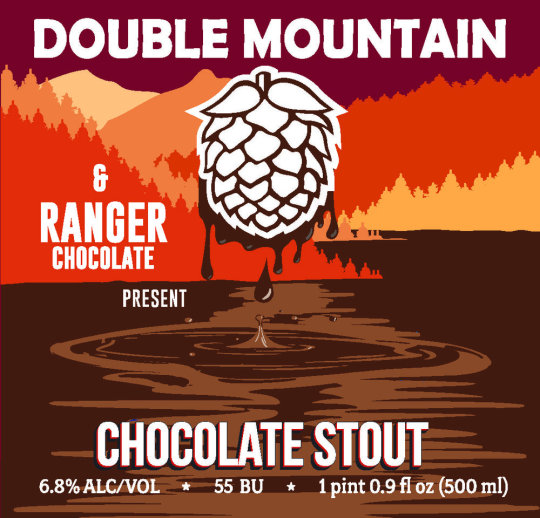
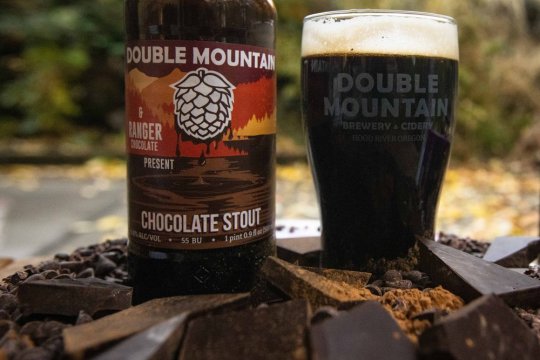
Press Release
Hood River, OR - November 2021
Double Mountain Brewery & Cidery’s final seasonal of 2021 coincides with the arrival of colder temps, shorter days, flannel shirts, and the end of another year. This delectable Chocolate Stout will add some comfort to your palate with a touch of sweetness making you think of powder days and good things to come. Brewed in collaboration with Ranger Chocolate Co., this smooth stout is perfect for cooler days. Notes of dark bread, baking chocolate, molasses, and dark fruit lead into a dry finish. The Double Mountain and Ranger collaboration Chocolate Stout is available in refillable 500ml bottles and on draft at our Hood River Taproom, SE Portland Taproom in the Woodstock neighborhood, and at fine establishments throughout the Northwest.
Chocolate Stout 6.8% ABV 55 BU
“We partnered with our Friends at Ranger Chocolate and made a stout because Beer is always better when it’s made of chocolate” Malachi Vanderpuye, Brewer Malachi Vanderpuye
REDUCE, REUSE, REPEAT!
With news appearing throughout media outlets on the shortcomings of recycling and OPB reporting that Oregon recycling is on the decline, we determined that there is no better time than the present to share the information on why to choose refillable bottles. Complimenting this delicious experimental series, each beer’s label highlights the benefits of using refillable bottles. The carbon footprint of refillable bottles is vastly lower than other container choices, making it the best container for the environment. Add the benefit of reduced oxidation, and refillable bottles are better for the beer too. Reduce, Reuse, Repeat, a solid mantra, not only for refillable bottles but containers in general.
About Double Mountain Brewery and Cidery:
Double Mountain Brewery and Cidery was established in 2007 in the heart of downtown Hood River, OR. Founder, Matt Swihart, opened the brewery with a clear mission: make great beer for craft beer fans. The unique location of Double Mountain provides the use of pure and clean glacial water for beers and ciders, while also taking advantage of regionally grown hops. Reusable bottles allow customers to partake in a softer environmental footprint, affirming they are part of a sustainable future. Double Mountain may be found on tap and in bottles throughout the Pacific Northwest and British Columbia.
Learn more at www.doublemountainbrewery.com
from Northwest Beer Guide - News - The Northwest Beer Guide https://bit.ly/3BISGi4
0 notes
Text
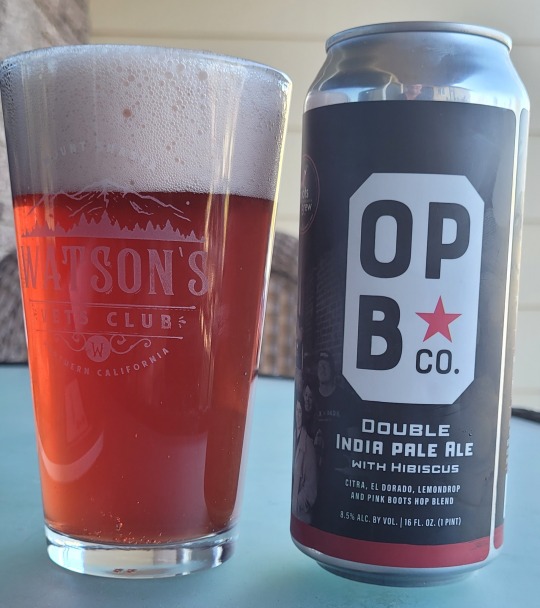

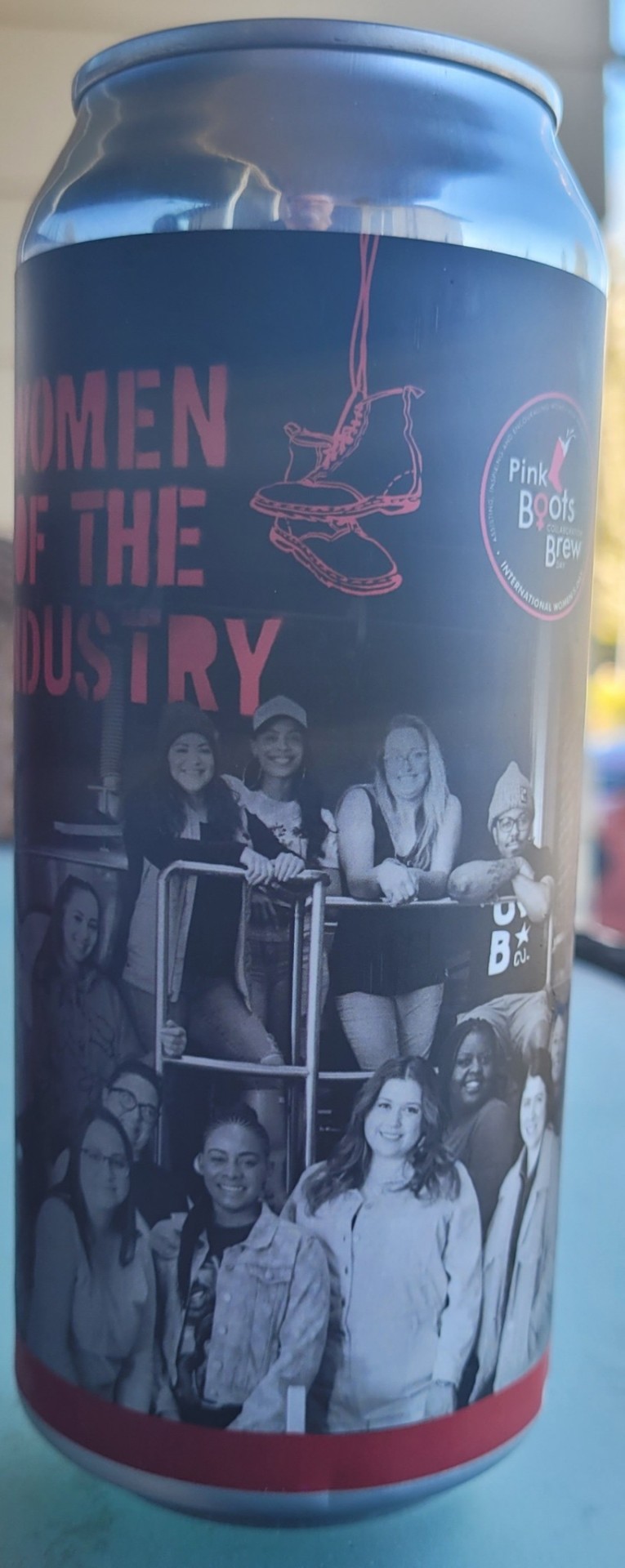
. . . and gravy.
#opb co.#double india pale ale#hibiscus#citra#el dorado#lemondrop#pink boots#pink boots society#women of the industry#oak park brewing co.#sacramento#california#pink boots corporation brew day
3 notes
·
View notes
Photo

Catch Anjali and I on OPB’s Think Out Loud today at 12:30 pm. Photo by Eden Swartz. https://www.instagram.com/p/CO-8AjvBUi6/?igshid=1cvjw4sx5ivd2
0 notes
Link
The Law Enforcement Violence Trump Won’t Talk About
Day after day, night after night, protesters have been taking to the streets since the police killing of George Floyd. Led by local Black activists and grassroots groups, they’re chanting, singing, shouting, kneeling, marching, and even laying on the ground to demand justice for the many Black lives that have been taken by police. Everyone — from parents, grandparents, kids, and more — are showing up.
But Donald Trump from day one has expressed extreme hostility towards the Black Lives Matter movement. He has called on NFL owners to retaliate against players who dared to kneel in protest, said it was “terrible” to ask why Black Americans are still dying at the hands of law enforcement in this country, compared police killing and injuring Black people to golfers who “choke,” and has called for law enforcement to “dominate” protesters demanding that our legal system value Black lives. He has even encouraged police to abuse people in their custody.
As the movement and calls for change gain broader support from more Americans and people around the world, protesters are being met by even more brutality — in many cases by the same police departments whose racism and brutality they are protesting. Police and federal agents are spreading fear and panic in communities, threatening lives, and relentlessly attacking people simply exercising their First Amendment right to protest police racism and brutality. Law enforcement at all levels haven’t even spared U.S. military veterans, journalists, legal observers, and medics. This assault on the First Amendment has only escalated tensions, and emboldened white supremacists to spread terror and hate on our streets.
The ACLU is taking to the streets, legislatures and courts nationwide to demand an end to police violence and accountability for rights violations. Here is just a partial running list of federal and local law enforcement abuses against individuals exercising their First Amendment rights in Portland, Oregon:
Federal agents with the U.S. Marshals Service brutally attacked and gassed U.S. Navy veteran Christopher David, who went to the protest to oppose police brutality and ask federal agents why they weren’t upholding their oath to the Constitution. The ACLU of Oregon is now suing on his behalf.
https://twitter.com/ACLU/statuses/1299896621711454208
Unidentified federal agents in military-style uniforms abducted ACLU of Oregon client Mark Pettibone from a sidewalk, then forced him into an unmarked minivan and drove him away for no apparent reason. The agents were later identified as belonging to Trump’s Department of Homeland Security. Pettibone explains how he “still [hasn’t] fully come to terms with what it means that I was kidnapped by [his] government.”
DHS officers violently attacked Nichol Denison, a U.S. Air Force veteran and member of the Portland “Wall of Moms,” while she was attending a Black Lives Matter protest. Without any warning, officers began launching cans of tear gas at her and other women beside her through gaps in the fence. Denison was hit repeatedly and was then struck far more forcefully in the head by a tear gas cannister that appeared to have been thrown from in front of her. She suffered a three-inch gash that was gushing blood, had to be taken to the VA hospital, where she received 11 stitches.
Without warning and for no reason whatsoever, federal officers shot James McNulty, who was attending a protest for the first time, four times: three times with rubber bullets and one time with a pepper ball. At the emergency room, McNulty learned that one of the munitions that struck him in the back had not only gone through his clothes, but pieced his skin, fat layer, and at least one layer of muscle.

James McNulty sustains deep wound after federal officers fire munitions at him at a protest in Portland, Oregon.
Maureen Healy was attending a Black Lives Matter protest with her child when, without warning, federal officers began firing flash bangs, impact munitions, and tear gas cannisters into the crowd. Healy began to turn and run, but was hit in the head with a projectile that felt metallic and the size of a small can. She started bleeding profusely and called for help. While some volunteer medics attended to her injuries, federal officers continued to fire tear gas into the area, forcing them all to move.
Federal officers shot Donovan LaBella, a 26-year-old protester, in the head with impact munitions. At the time LaBella was shot, he was standing across the street from the Hatfield Courthouse protesting while holding a music speaker above his head. He suffered severe injuries, arriving at the hospital in critical condition with a skull fracture. He subsequently underwent facial reconstruction surgery for his injuries.
Mac Smiff was attending a Black Lives Matter protest when federal officers shot him on the right side of his face with an indelible hard-cap paintball, just below the line of his helmet and just above a face mask he was wearing. The impact of the shot and resulting shock caused Smiff to fall to the ground. Smiff was partly blinded by the paint in his face and had a large contusion on his head. He received treatment from the volunteer medics, who told him that he may have suffered a concussion.
Duston Obermeyer, a decorated USMC veteran with combat experience in Iraq and Afghanistan and a co-founder of the “Wall of Vets,” was attending the Portland protests for the first time when, for no reason, a federal officer tried to strike Obermeyer. An officer pointed an automatic weapon in Obermeyer’s face while another officer shot him at point-blank range with an orange chemical irritant. One of the officers also struck Obermeyer in the face and chest with a baton. The gas was severely debilitating, and it took Duston days to recover from the gassing.
Portland police tear-gassed reporters Alex Zielinski and Blair Stenvick of the Portland Mercury, many other journalists and legal observers, and physically assaulted and arrested KBOO reporter Cory Elia, even though he identified himself as press.
https://www.youtube.com/embed/im0l3HuYgNw
Police hit freelance journalist Sergio Olmos with a truncheon and threatened to tear gas him because he was recording them. His press pass was clearly visible. Police also attacked journalist Donovan Farley with a wooden bat and sprayed him in the face with tear gas or pepper spray while he was trying to walk away from them. He had identified himself as press and was filming several police officers kneeling on a protester’s neck, Derek Chauvin-style.
Portland police slammed reporter Beth Nakamura of The Oregonian in the back with a truncheon. She had her hands up, press pass in hand, and was saying “press, press.” The officer responded: “I don’t give a fuck.” The same day, police ordered reporter Zane Sparling of The Portland Tribune to leave an area where they were enforcing a dispersal order against protesters. Sparling responded that he was media. The officer responded: “I don’t give a shit! Go!” He then shoved Sparling into a wall, and another officer shot a crowd-control munition at his heel.
When the police noticed journalist Brian Conley using his camera to record their action, officers launched at least one flash-bang grenade directly at him. He was nowhere near any protesters and there was no other target at which the police could have been aiming. The police later charged at him after telling him that it did not matter if he was media. Conley fell over while running away and only narrowly avoided a traumatic head injury.
Portland police repeatedly sprayed large groups of protesters with tear gas from all sides in what is known as a “kettling” or “killbox” military strategy. Killboxing protesters cannot disperse them. Its sole purpose is to inflict pain and suffering.
Portland police have bull-rushed crowds of people, shoving protesters to the ground, and hitting them with clubs and other instruments. They continue to do this night-after-night.
https://twitter.com/MrOlmos/statuses/1300682200082345985
Federal agents too have been deliberately attacking journalists and legal observers at protests, even after a court issued a temporary restraining order barring them from such unconstitutional attacks. A federal agent shot reporter Jonathan Levinson while he was trying to take a photo. As Levinson looked back and forth between his camera and the agent, trying to focus his lens, he saw the agent raise his weapon, deliberately point it at him, and fire several rounds. Levinson was wearing an OPB press pass with his name, his photograph, the OPB logo, and the word “MEDIA.” He was also wearing a helmet that said “PRESS” in large letters on the front and back and carrying two professional cameras with large, bulky lenses.
A federal agent also shot journalist Brian Conley when he was trying to video an arrest. Conley yelled that he was press, over and over. Suddenly, without warning, federal agents shot him multiple times with impact munitions in his chest and his foot. An agent also threw a tear-gas canister directly at Conley, where it exploded above his head. He was carrying a large Micro Four Thirds camera with a telephoto lens and external 20W LED light mounted on it and was wearing a photographer’s vest that said “PRESS” on it as well as a helmet that said “PRESS.”
Federal agents shot clearly-marked reporter Rebecca Ellis and separately prevented her from documenting their dispersal of protesters.
Federal agents shot clearly-marked legal observer Haley Nicholson in her chest, just above her heart, from four feet away. Impact munitions should not be used at distances of less than 15 feet or above the waist.
Federal agents deliberately sprayed toxic chemicals into the faces of multiple clearly-marked legal observers, including Bruce Knivlia and Kat Mahoney, at point blank range. They were all clearly identified in blue ACLU vests and green NLG hats. They also shot photojournalist Kathryn Elsesser, who was also clearly marked with “PRESS” on her helmet.
Daniel Hollis, a videographer for VICE News, was wearing a helmet with the word “PRESS” on it and operating large, professional video-recording equipment when federal agents launched a barrage of munitions at Hollis and the members of the press around him, hitting Hollis near his groin and in his lower back.
Federal agents and Portland police have also brutally attacked protest medics treating injured protesters and individuals. ACLU of Oregon clients Christopher Wise, Savannah Guest, and others have suffered numerous injuries from law enforcement deliberately firing rubber bullets, tear-gas, pepper spray, batons, and flash bangs at protest medics providing aid.
https://twitter.com/ACLU/statuses/1287019018147237891
We’re witnessing similarly alarming and dangerous tactics being deployed in Kenosha, Wisconsin as people take to the streets to demand accountability and transformational change within the police and sheriff’s departments. This comes after police attempted to murder Jacob Blake by shooting him seven times in the back, fraternized with heavily-armed white supremacist militias during protests, and then let a white man who shot and killed two protesters walk away from the scene of the shooting.
There are multiple reports of law enforcement in unmarked vehicles with tinted windows and officers making arrests in Kenosha without identifying themselves or wearing insignia to identify their law enforcement agency. Kenosha police have also indiscriminately fired chemical and other weapons, including tear gas, pepper spray, rubber bullets, and pepper balls at protesters. We’re also receiving reports of protesters being arrested for violating curfew, and having possessions, like their cell phones, confiscated and not returned to them.
Notably, all of this is taking place in a county that has a history of severe racial disparities in policing; Black people in Kenosha County are 6.9 times more likely to be arrested for marijuana possession than white people — almost double the national racial disparity in such arrests.
This is a fight for our democracy. The answer to protests over police brutality cannot be more brutality. We are unleashing the full firepower of the ACLU to defend our rights — in Portland, in Kenosha, and nationwide. We won’t be silenced.
Published September 2, 2020 at 12:59AM
via ACLU https://ift.tt/34T4MZe
0 notes
Text
The Law Enforcement Violence Trump Won’t Talk About
Day after day, night after night, protesters have been taking to the streets since the police killing of George Floyd. Led by local Black activists and grassroots groups, they’re chanting, singing, shouting, kneeling, marching, and even laying on the ground to demand justice for the many Black lives that have been taken by police. Everyone — from parents, grandparents, kids, and more — are showing up.
But Donald Trump from day one has expressed extreme hostility towards the Black Lives Matter movement. He has called on NFL owners to retaliate against players who dared to kneel in protest, said it was “terrible” to ask why Black Americans are still dying at the hands of law enforcement in this country, compared police killing and injuring Black people to golfers who “choke,” and has called for law enforcement to “dominate” protesters demanding that our legal system value Black lives. He has even encouraged police to abuse people in their custody.
As the movement and calls for change gain broader support from more Americans and people around the world, protesters are being met by even more brutality — in many cases by the same police departments whose racism and brutality they are protesting. Police and federal agents are spreading fear and panic in communities, threatening lives, and relentlessly attacking people simply exercising their First Amendment right to protest police racism and brutality. Law enforcement at all levels haven’t even spared U.S. military veterans, journalists, legal observers, and medics. This assault on the First Amendment has only escalated tensions, and emboldened white supremacists to spread terror and hate on our streets.
The ACLU is taking to the streets, legislatures and courts nationwide to demand an end to police violence and accountability for rights violations. Here is just a partial running list of federal and local law enforcement abuses against individuals exercising their First Amendment rights in Portland, Oregon:
Federal agents with the U.S. Marshals Service brutally attacked and gassed U.S. Navy veteran Christopher David, who went to the protest to oppose police brutality and ask federal agents why they weren’t upholding their oath to the Constitution. The ACLU of Oregon is now suing on his behalf.
https://twitter.com/ACLU/statuses/1299896621711454208
Unidentified federal agents in military-style uniforms abducted ACLU of Oregon client Mark Pettibone from a sidewalk, then forced him into an unmarked minivan and drove him away for no apparent reason. The agents were later identified as belonging to Trump’s Department of Homeland Security. Pettibone explains how he “still [hasn’t] fully come to terms with what it means that I was kidnapped by [his] government.”
DHS officers violently attacked Nichol Denison, a U.S. Air Force veteran and member of the Portland “Wall of Moms,” while she was attending a Black Lives Matter protest. Without any warning, officers began launching cans of tear gas at her and other women beside her through gaps in the fence. Denison was hit repeatedly and was then struck far more forcefully in the head by a tear gas cannister that appeared to have been thrown from in front of her. She suffered a three-inch gash that was gushing blood, had to be taken to the VA hospital, where she received 11 stitches.
Without warning and for no reason whatsoever, federal officers shot James McNulty, who was attending a protest for the first time, four times: three times with rubber bullets and one time with a pepper ball. At the emergency room, McNulty learned that one of the munitions that struck him in the back had not only gone through his clothes, but pieced his skin, fat layer, and at least one layer of muscle.

James McNulty sustains deep wound after federal officers fire munitions at him at a protest in Portland, Oregon.
Maureen Healy was attending a Black Lives Matter protest with her child when, without warning, federal officers began firing flash bangs, impact munitions, and tear gas cannisters into the crowd. Healy began to turn and run, but was hit in the head with a projectile that felt metallic and the size of a small can. She started bleeding profusely and called for help. While some volunteer medics attended to her injuries, federal officers continued to fire tear gas into the area, forcing them all to move.
Federal officers shot Donovan LaBella, a 26-year-old protester, in the head with impact munitions. At the time LaBella was shot, he was standing across the street from the Hatfield Courthouse protesting while holding a music speaker above his head. He suffered severe injuries, arriving at the hospital in critical condition with a skull fracture. He subsequently underwent facial reconstruction surgery for his injuries.
Mac Smiff was attending a Black Lives Matter protest when federal officers shot him on the right side of his face with an indelible hard-cap paintball, just below the line of his helmet and just above a face mask he was wearing. The impact of the shot and resulting shock caused Smiff to fall to the ground. Smiff was partly blinded by the paint in his face and had a large contusion on his head. He received treatment from the volunteer medics, who told him that he may have suffered a concussion.
Duston Obermeyer, a decorated USMC veteran with combat experience in Iraq and Afghanistan and a co-founder of the “Wall of Vets,” was attending the Portland protests for the first time when, for no reason, a federal officer tried to strike Obermeyer. An officer pointed an automatic weapon in Obermeyer’s face while another officer shot him at point-blank range with an orange chemical irritant. One of the officers also struck Obermeyer in the face and chest with a baton. The gas was severely debilitating, and it took Duston days to recover from the gassing.
Portland police tear-gassed reporters Alex Zielinski and Blair Stenvick of the Portland Mercury, many other journalists and legal observers, and physically assaulted and arrested KBOO reporter Cory Elia, even though he identified himself as press.
https://www.youtube.com/embed/im0l3HuYgNw
Police hit freelance journalist Sergio Olmos with a truncheon and threatened to tear gas him because he was recording them. His press pass was clearly visible. Police also attacked journalist Donovan Farley with a wooden bat and sprayed him in the face with tear gas or pepper spray while he was trying to walk away from them. He had identified himself as press and was filming several police officers kneeling on a protester’s neck, Derek Chauvin-style.
Portland police slammed reporter Beth Nakamura of The Oregonian in the back with a truncheon. She had her hands up, press pass in hand, and was saying “press, press.” The officer responded: “I don’t give a fuck.” The same day, police ordered reporter Zane Sparling of The Portland Tribune to leave an area where they were enforcing a dispersal order against protesters. Sparling responded that he was media. The officer responded: “I don’t give a shit! Go!” He then shoved Sparling into a wall, and another officer shot a crowd-control munition at his heel.
When the police noticed journalist Brian Conley using his camera to record their action, officers launched at least one flash-bang grenade directly at him. He was nowhere near any protesters and there was no other target at which the police could have been aiming. The police later charged at him after telling him that it did not matter if he was media. Conley fell over while running away and only narrowly avoided a traumatic head injury.
Portland police repeatedly sprayed large groups of protesters with tear gas from all sides in what is known as a “kettling” or “killbox” military strategy. Killboxing protesters cannot disperse them. Its sole purpose is to inflict pain and suffering.
Portland police have bull-rushed crowds of people, shoving protesters to the ground, and hitting them with clubs and other instruments. They continue to do this night-after-night.
https://twitter.com/MrOlmos/statuses/1300682200082345985
Federal agents too have been deliberately attacking journalists and legal observers at protests, even after a court issued a temporary restraining order barring them from such unconstitutional attacks. A federal agent shot reporter Jonathan Levinson while he was trying to take a photo. As Levinson looked back and forth between his camera and the agent, trying to focus his lens, he saw the agent raise his weapon, deliberately point it at him, and fire several rounds. Levinson was wearing an OPB press pass with his name, his photograph, the OPB logo, and the word “MEDIA.” He was also wearing a helmet that said “PRESS” in large letters on the front and back and carrying two professional cameras with large, bulky lenses.
A federal agent also shot journalist Brian Conley when he was trying to video an arrest. Conley yelled that he was press, over and over. Suddenly, without warning, federal agents shot him multiple times with impact munitions in his chest and his foot. An agent also threw a tear-gas canister directly at Conley, where it exploded above his head. He was carrying a large Micro Four Thirds camera with a telephoto lens and external 20W LED light mounted on it and was wearing a photographer’s vest that said “PRESS” on it as well as a helmet that said “PRESS.”
Federal agents shot clearly-marked reporter Rebecca Ellis and separately prevented her from documenting their dispersal of protesters.
Federal agents shot clearly-marked legal observer Haley Nicholson in her chest, just above her heart, from four feet away. Impact munitions should not be used at distances of less than 15 feet or above the waist.
Federal agents deliberately sprayed toxic chemicals into the faces of multiple clearly-marked legal observers, including Bruce Knivlia and Kat Mahoney, at point blank range. They were all clearly identified in blue ACLU vests and green NLG hats. They also shot photojournalist Kathryn Elsesser, who was also clearly marked with “PRESS” on her helmet.
Daniel Hollis, a videographer for VICE News, was wearing a helmet with the word “PRESS” on it and operating large, professional video-recording equipment when federal agents launched a barrage of munitions at Hollis and the members of the press around him, hitting Hollis near his groin and in his lower back.
Federal agents and Portland police have also brutally attacked protest medics treating injured protesters and individuals. ACLU of Oregon clients Christopher Wise, Savannah Guest, and others have suffered numerous injuries from law enforcement deliberately firing rubber bullets, tear-gas, pepper spray, batons, and flash bangs at protest medics providing aid.
https://twitter.com/ACLU/statuses/1287019018147237891
We’re witnessing similarly alarming and dangerous tactics being deployed in Kenosha, Wisconsin as people take to the streets to demand accountability and transformational change within the police and sheriff’s departments. This comes after police attempted to murder Jacob Blake by shooting him seven times in the back, fraternized with heavily-armed white supremacist militias during protests, and then let a white man who shot and killed two protesters walk away from the scene of the shooting.
There are multiple reports of law enforcement in unmarked vehicles with tinted windows and officers making arrests in Kenosha without identifying themselves or wearing insignia to identify their law enforcement agency. Kenosha police have also indiscriminately fired chemical and other weapons, including tear gas, pepper spray, rubber bullets, and pepper balls at protesters. We’re also receiving reports of protesters being arrested for violating curfew, and having possessions, like their cell phones, confiscated and not returned to them.
Notably, all of this is taking place in a county that has a history of severe racial disparities in policing; Black people in Kenosha County are 6.9 times more likely to be arrested for marijuana possession than white people — almost double the national racial disparity in such arrests.
This is a fight for our democracy. The answer to protests over police brutality cannot be more brutality. We are unleashing the full firepower of the ACLU to defend our rights — in Portland, in Kenosha, and nationwide. We won’t be silenced.
from RSSMix.com Mix ID 8247012 https://www.aclu.org/news/criminal-law-reform/the-law-enforcement-violence-trump-wont-talk-about
via http://www.rssmix.com/
0 notes
Text
His Business Got Looted. He’s Still Protesting.
Co-host of The Journal., The Wall Street Journal
Follow
Kate Linebaugh is the co-host of The Journal. She has worked at The Wall Street Journal for 15 years, most recently as the deputy U.S. news coverage chief. Kate started at the Journal in Hong Kong, stopping in Detroit and coming to New York in 2011. As a reporter, she covered everything from post-9/11 Afghanistan to the 2004 Asian tsunami, from Toyota’s sudden acceleration recall to General Electric. She holds a bachelor degree from the University of Michigan in Ann Arbor and went back to campus in 2007 for a Knight-Wallace fellowship.

Co-host of The Journal., The Wall Street Journal
Follow
Ryan Knutson is the co-host of The Journal. Previously, he spent more than four years in the newsroom covering the wireless industry, and was responsible for a string of scoops including Verizon’s $130 billion buyout of Vodafone’s stake in their joint venture, Sprint and T-Mobile’s never ending courtship and a hack of the 911 emergency system that spread virally on Twitter. He was also a regular author of A-heds, including one about millennials discovering TV antennas. Previously, he reported for ProPublica, PBS Frontline and OPB, the NPR affiliate station in Portland, Ore. He grew up in Beaverton, Ore. and graduated from the University of Oregon.
%%
from Job Search Tips https://jobsearchtips.net/his-business-got-looted-hes-still-protesting/
0 notes
Quote
A new study says Oregon’s path-breaking automatic voter registration system helped make the state’s voting population more diverse. A study co-authored by Paul Gronke, a Reed College political scientist and expert on voting issues, found that automatically registering voters through the DMV helped bring in more under-represented groups. In particular, it led to more voting by ethnic minorities, younger people and those who are low-income and more rural. “This report finds significant demographic and geographic differences between these newly registered voters and those who registered through traditional means,” said the study, prepared for the Center for American Progress, a Washington, D.C., think tank. The study projected that Oregon’s new system added to the voting rolls about 116,000 new people who would have been unlikely to register by traditional means. And about 40,000 of those “previously disengaged people” voted in November, according to the study.
Study: Oregon 'Motor Voter' Program Boosted Turnout And Diversity Of Voters . News | OPB
8 notes
·
View notes
Photo

We’re Hitting The Road With The Tiny Desk Contest
For the first few months of 2017, you came to us. You sent us your videos and your stories, and we watched and read them all. Now, we’re coming to you. On a 10-city tour, we’re hitting the road with Tank and the Bangas and some of our favorite regional Contest entrants to bring the Tiny Desk Contest to life.
So grab a free ticket. We’ll see you on the road.
Here are the stops we’re making, and the great NPR Member stations we’re partnering with along the way. Just click on the links to claim your free tickets. As we go to each city, we’ll be celebrating some of the amazing talent we saw from each area — Tank and the Bangas will join some of the bills with our local acts (we’ve marked those below), and some will be filled entirely with local entrants. And I’ll be at all of the stops, so come say hi when you stop by. Just look for the hat.
April 24 (SOLD OUT) NPR’s Ask Me Another with WNYC ft. Tank and the Bangas - Brooklyn, N.Y. | The Bell House
April 26 Tiny Desk Contest On The Road with WFUV - New York, N.Y. | Rockwood Music Hall
May 2 Tiny Desk Contest On The Road with WXPN - Philadelphia, Pa. | World Cafe Live
May 8 Tiny Desk Contest On The Road with KEXP - Seattle, Wash. | KEXP’s Gathering Space
May 9 Tiny Desk Contest On The Road with KQED and KRCB ft. Tank and the Bangas - Petaluma, Calif. | Lagunitas TapRoom
May 10 Tiny Desk Contest On The Road with OPB ft. Tank and the Bangas - Portland, Ore. | Lagunitas Community Room
May 11 Tiny Desk Contest On The Road with KVCR ft. Tank and the Bangas - Azusa, Calif. | Lagunitas TapRoom
May 16 Tiny Desk Contest On The Road with WBEZ ft. Tank and the Bangas - Chicago, Ill. | Lagunitas TapRoom
May 22 Tiny Desk Contest On The Road with South Carolina Public Radio ft. Tank and the Bangas - Charleston, S.C. | Lagunitas TapRoom
May 23 Tiny Desk Contest On The Road with WPLN and WMOT -Nashville, Tenn. | The Basement East
May 24 Tiny Desk Contest On The Road with KUTX ft. Tank and the Bangas - Austin, Texas | Independence Brewing Co.
Last year, this was one of the most fun parts of the Contest. It means so much to us to be able to see this community in person, and to hear the music you sent us transformed on the stage. We can’t wait to see you in person.
From the Tiny Desk,
Bob Boilen
4 notes
·
View notes